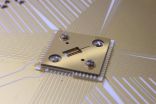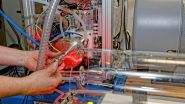(Press-News.org) CLEMSON, S.C. -- If you've been to the doctor, you probably know what to do when you're handed a plastic cup and shown to the bathroom.
Most patients hand over the sample and give little thought to what happens when it's shipped to the lab for analysis.
Ken Marcus and his students are the exceptions. They have developed a new testing method that they believe will reduce costs, get faster results and lower the volume of urine needed for a sample.
Marissa Pierson, a master's student, closes the lid on a centrifuge while working in a Clemson University lab with Ken Marcus.
It's great news for patients who get the willies when the nurse pulls out the needle to draw blood. The method Marcus and his students have developed could help make it possible to use urine instead of blood to test for more diseases.
Proteins in urine, for example, could help detect early signs of coronary heart disease, tell whether the body is rejecting a transplanted kidney and show whether someone has sleeping sickness.
The trouble with testing urine is that it's awash in salt, Marcus said. It can be tricky to isolate the proteins that act as biomarkers. Those biomarkers are the clues that tell whether the patient is sick or has ingested a drug.
"You've got almost seawater coming out of you, and I'm trying to find something far smaller than a needle in a haystack," Marcus said. "The concentrations of these proteins would be one part in a billion."
The magic ingredient in the group's research looks like kite string, but it's no ordinary twine. It's made of capillary-channeled polymer fibers.
As part of a study, Marcus and his students packed the fibers into plastic tubes and then passed urine samples through the tubes by spinning them in a centrifuge for 30 seconds. Then the researchers ran de-ionized water through the tubes for a minute to wash off salt and other contaminants.
Proteins are hydrophobic, so they remained stuck to the fibers. Researchers extracted the proteins by running a solvent through the tubes in the centrifuge for 30 seconds.
When it was all done, researchers were left with purified proteins that could be stored in a plastic vial and refrigerated until it's time for testing. The team was able to extract 12 samples in about five minutes, limited only by centrifuge capacity.
In urine tests commonly used now, polymer beads extract the proteins.
"The difference is that ours is smaller, faster and cheaper," Marcus said.
The team's work was recently published by the journal Proteomics-Clinical Applications. The authors were Benjamin T. Manard, Sarah M.H. Jones and Marcus.
In a review of the article, professor Youhe Gao of Beijing Normal University wrote that the method "may have more profound implications than the authors have claimed, simply because urine is more important than most biomarker researchers realize."
Various mechanisms in the body limit changes in the blood. Urine, however, "accumulates all kinds of changes and should be a better biomarker source than blood," Gao wrote.
Further, urine is the mostly easily obtained bodily fluid, he wrote. Sweat can also be obtained noninvasively, but it may not be as informative and free of contaminants as urine, Gao wrote.
The new method should also make it easier to test urine samples from babies, Marcus said. One of the challenges now is getting a large enough sample. But the new method requires only a few microliters of urine.
The research has been about a decade in the making with various students working on it over the years. They include W. Clay Davis, Dwella M. Nelson, Brad Knippel, Rayman D. Stannelle, Christine M. Straut, Tim M. Brewer, Jennifer J. Pittman, Manoj Randunu, Benjamin T. Manard, Carolyn Q. Burdette and Abby J. Schadock-Hewitt.
For Marcus, the most important thing is to create a research environment that produces well-prepared graduates.
Marcus, a professor of analytical chemistry, said that he has graduated 33 Ph.D. students with more than half going on to work for national labs. Others work in industry and for the Centers for Disease Control and Prevention. Still others in his lab are focused on the development of analytical methods for post-detonation nuclear forensics.
"My pride is putting those people out and seeing them get really good jobs," Marcus said.
Marissa Pierson, a master's student from Pittsburgh, is among the latest crop of students to work in Marcus' lab. On a recent morning, she was putting samples in the centrifuge.
"It's a really awesome place to work," she said. "It's good to know that people will use this."
Karl Dieter, the chair of the chemistry department, said it is heartening to see a professor so passionate about his students.
"Ken has created scientists that have gone on to exciting, impressive careers," Dieter said. "When they graduate, they are ready to get some of the most desirable jobs in their field and contribute immediately."
INFORMATION:
This news release is available in German.
Quantum physics is full of fascinating phenomena. Take, for instance, the cat from the famous thought experiment by the physicist Erwin Schrodinger. The cat can be dead and alive at once, since its life depends on the quantum mechanically determined state of a radioactively decaying atom which, in turn, releases toxic gas into the cat's cage. As long as one hasn't measured the state of the atom, one knows nothing about the poor cat's health either - atom and kitty are intimately "entangled" with each other.
Equally striking, ...
This news release is available in German.
Leipzig / Helsinki. A first global scale study has estimated how forest emitted compounds affecting cloud seeds via formation of low-volatility vapours. According to the latest projections, terrestrial vegetation emits several million tons of extremely low-volatility organic compounds (ELVOCs) per year to the atmosphere. These oxidation products of compounds such as monoterpenes results in an increase of condensing vapours that can further form cloud condensation nuclei over the continents and thus has an influence ...
Montréal, May 25, 2015 - A team of researchers at the IRCM led by François Robert, PhD, uncovered a critical role for two proteins in chromatin structure. Their breakthrough, recently published in the scientific journal Molecular Cell, helps explain how DNA is organized in our cells. This discovery could lead to a better understanding of what causes certain types of cancer, such as lymphoma.
Dr. Robert and his team study chromatin, the structure composed of DNA and proteins that makes up chromosomes. Its main role is to package DNA molecules containing all the ...
LOS ANGELES (May 26, 2015) - Biomedical researchers at Cedars-Sinai have invented a tiny drug-delivery system that can identify cancer cell types in the brain through "virtual biopsies" and then attack the molecular structure of the disease.
If laboratory research with mice is borne out in human studies, the results could be used to deliver nano-scale drugs that can distinguish and fight tumor cells in the brain without resorting to surgery.
"Our nanodrug can be engineered to carry a variety of drugs, proteins and genetic materials to attack tumors on several fronts ...
Queen's University PhD student Matt Shultz is researching magnetic, massive stars, and his research has uncovered questions concerning the behaviour of plasma within their magnetospheres.
Drawing upon the extensive dataset assembled by the international Magnetism in Massive Stars (MiMeS) collaboration, led by Mr. Shultz's supervisor, Queen's professor Gregg Wade, along with some of his own observations collected with both the Canada-France-Hawaii Telescope and the European Southern Observatory's Very Large Telescope, Mr. Shultz is conducting the first systematic population ...
Washington, D.C. -- May 26, 2015 -- A new study has demonstrated that a protein called Niemann-Pick C1 (NPC1) is critical for the Ebola virus to infect a host. The study, published in the May/June issue of mBio, the online open-access journal of the American Society for Microbiology, suggests that drugs that block NPC1 could be used to treat this deadly disease.
"The science behind the concept of blocking the interaction between NPC1 and the virus is solid. Now, it is just a matter of powering through and identifying drugs that can inhibit NPC1 and moving them forward," ...
An international team including scientists from Albert Einstein College of Medicine of Yeshiva University and the U.S. Army Medical Research Institute of Infectious Diseases (USAMRIID) has identified the molecular "lock" that the deadly Ebola virus must pick to gain entry to cells. The findings, made in mice, suggest that drugs blocking entry to this lock could protect against Ebola infection. The study was published in today's edition of the online journal mBio.
The researchers found that the Ebola virus can't infect cells unless it first attaches to a host protein called ...
By unlocking the secrets of a bizarre virus that survives in nearly boiling acid, scientists at the University of Virginia School of Medicine have found a blueprint for battling human disease using DNA clad in near-indestructible armor.
"What's interesting and unusual is being able to see how proteins and DNA can be put together in a way that's absolutely stable under the harshest conditions imaginable," said Edward H. Egelman, PhD, of the UVA Department of Biochemistry and Molecular Genetics. "We've discovered what appears to be a basic mechanism of resistance - to ...
Mitsuyoshi Nakao, Director of the Institute of Molecular Embryology and Genetics in Kumamoto University and Associate Professor Noriko Saitoh revealed that a cluster of defined, non-coding RNAs are mechanistically involved in endocrine therapy resistance in human breast cancer cells. Furthermore, resveratrol, a kind of polyphenol, was found to repress these RNAs and inhibit the proliferative activity of breast cancer cells which had acquired resistance. The work was published in Nature Communications on April 29th, 2015.
Breast cancer is one of the most common types ...
This news release is available in French.
Commuting length, distance, and means are stress factors that can lead to burnout, says Annie Barreck of the University of Montreal's School of Industrial Relations. "A correlation exists between commuting stress factors and the likelihood of suffering from burnout. But their importance varies according to the individual, the conditions in which their trips take place, and the place where the individual works," she explained. Barreck will present her research today at the 83rd congress of the Association francophone pour ...



